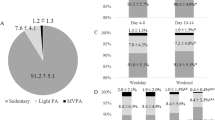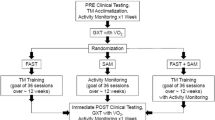Abstract
Background
We aimed to determine whether a history of falls before admission affected physical activity levels and sedentary behavior negatively after implementing a behavior modification approach in patients with minor ischemic stroke.
Methods
This study constituted a secondary analysis of an intervention trial. In the intervention study, patients with minor ischemic stroke were randomly assigned to two groups: intervention and control groups. The intervention group was encouraged to reduce sedentary behavior during hospitalization and after discharge, while the control group was encouraged to increase physical activity levels solely during hospitalization. The study included 52 patients who completed the intervention trial. The exposure factor examined was a history of falls. Upon admission, patients were queried about any falls experienced in the year preceding admission and subsequently classified into fall and non-fall groups based on their responses. The primary outcome of interest focused on changes in physical activity levels (step count, light-intensity physical activity, and moderate-to-vigorous-intensity physical activity) and sedentary behavior. Measurements were obtained at two time points: before the intervention, during hospitalization (baseline), and 3 months after discharge (post-intervention).
Results
Only a significantly lower change in the number of steps taken in the fall group than in the non-fall group was found.
Conclusion
Those with a history of falls showed a lesser change in the number of steps taken before and after implementing a behavior change approach compared with those without a history of falls. Those with a history of falls may have engaged in activities other than walking.

Similar content being viewed by others
Data Availability
Research data is confidential.
References
Kaufman BG, Shah S, Hellkamp AS, et al. Disease burden following non-cardioembolic minor ischemic stroke or high-risk TIA: a GWTG-stroke study. J Stroke Cerebrovasc Dis. 2020;29(12):105399.
Kono Y, Yamada S, Kamisaka K, et al. Recurrence risk after noncardioembolic mild ischemic stroke in a Japanese population. Cerebrovasc Dis. 2011;31(4):365–72.
Bull FC, Al-Ansari SS, Biddle S, et al. World Health Organization 2020 guidelines on physical activity and sedentary behaviour. Br J Sports Med. 2020;54(24):1451–62.
Billinger SA, Arena R, Bernhardt J, et al. Physical activity and exercise recommendations for stroke survivors: a statement for healthcare professionals from the American Heart Association/American stroke association. Stroke. 2014;45(8):2532–53.
Hobeanu C, Lavallée PC, Charles H, et al. Risk of subsequent disabling or fatal stroke in patients with transient ischaemic attack or minor ischaemic stroke: an international, prospective cohort study. Lancet Neurol. 2022;21(10):889–98.
Ashizawa R, Honda H, Take K, et al. Approaches to promote reduction in sedentary behavior in patients with minor ischemic stroke: a randomized controlled trial. Arch Phys Med Rehabil. 2022;103(2):255–62.e4.
Russell D, Chase J-AD. The social context of sedentary behaviors and their relationships with health in later life. J Aging Phys Act. 2019;27(4):797–806.
Thilarajah S, Mentiplay BF, Bower KJ, Tan D, Pua YH, Williams G, et al. Factors associated with post-stroke physical activity: a systematic review and meta-analysis. Arch Phys Med Rehabil. 2018;99(9):1876–89.
Nakano W, Kobayashi S, Maezawa T, Ohashi Y, Kohno Y. Sex differences in physical activity in people after stroke: a cross-sectional study. Phys Ther Res. 2021;24(3):280–4.
Whipple MO, Pinto AJ, Abushamat LA, et al. Sex differences in physical activity among individuals with type 2 diabetes across the life span: a systematic review and meta-analysis. Diabetes Care. 2022;45(9):2163–77.
Fukui K, Maeda N, Komiya M, et al. The relationship between modified Short Physical performance battery and falls: a cross-sectional study of older outpatients. Geriatrics (Basel). 2021;6(4):106.
Park C, Atique MMU, Mishra R, Najafi B. Association between fall history and gait, balance, physical activity, depression, fear of falling, and motor capacity: a 6-month follow-up study. Int J Environ Res Public Health. 2022;19(17):10785.
Yuan Y, Li J, Fu P, Jing Z, Wang Y, Zhou C. Association between physical activity and falls among older adults in rural China: are there gender and age related differences? BMC Public Health. 2022;22(1):356.
Foong YC, Chherawala N, Aitken D, Scott D, Winzenberg T, Jones G. Accelerometer-determined physical activity, muscle mass, and leg strength in community-dwelling older adults: physical activity, muscle mass & strength in the elderly. J Cachexia Sarcopenia Muscle. 2016;7(3):275–83.
Thilarajah S, Bower KJ, Pua Y-H, et al. Modifiable factors associated with poststroke physical activity at discharge from rehabilitation: prospective cohort study. Phys Ther. 2020;100(5):818–28.
Tinetti ME, Kumar C. The patient who falls: “it’s always a trade-off”: “it’s always a trade-off.” JAMA. 2010;303(3):258–66.
Qian XX, Chen Z, Fong DYT, Ho M, Chau PH. Post-hospital falls incidence and risk factors among older adults: a systematic review and meta-analysis. Age Ageing. 2022;51(1):afab209.
Xu T, Clemson L, O’Loughlin K, Lannin NA, Dean C, Koh G. Risk factors for falls in community stroke survivors: a systematic review and meta-analysis. Arch Phys Med Rehabil. 2018;99(3):563–73.e5.
Nogueira Paranhos Amorim D, Nascimento DC, Stone W, Alves VP, Moraes CF, Coelho Vilaça e Silva KH. Muscle quality is associated with history of falls in octogenarians. J Nutr Health Aging. 2021;25(1):120–5.
Hamre C, Fure B, Helbostad JL, et al. Factors associated with level of physical activity after minor stroke. J Stroke Cerebrovasc Dis. 2021;30(4): 105628.
Lin C, Sangha R, Lee J, et al. Infarct location is associated with quality of life after mild ischaemic stroke. Int J Stroke. 2018;13(8):824–31.
Sangha RS, Caprio FZ, Askew R, et al. Quality of life in patients with TIA and minor ischaemic stroke. Neurology. 2015;85(22):1957–63.
Gibson MJ. Falls in later life. In: Improving the health of older people: a world view. Oxford University Press; 1990. p. 296–315.
Ohkawara K, Oshima Y, Hikihara Y, Ishikawa-Takata K, Tabata I, Tanaka S. Real-time estimation of daily physical activity intensity by a triaxial accelerometer and a gravity-removal classification algorithm. Br J Nutr. 2011;105(101):1681–91.
Nagayoshi S, Oshima Y, Ando T, et al. Validity of estimating physical activity intensity using a triaxial accelerometer in healthy adults and older adults. BMJ Open Sport Exerc Med. 2019;5(1): e000592.
Sedentary Behaviour Research Networ. Letter to the editor: standardized use of the terms “sedentary” and “sedentary behaviours.” Appl Physiol Nutr Metab. 2012;37(3):540–2.
Garber CE, Blissmer B, Deschenes MR, et al. American College of Sports Medicine position stand. Quantity and quality of exercise for developing and maintaining cardiorespiratory, musculoskeletal, and neuromotor fitness in apparently healthy adults: guidance for prescribing exercise: guidance for prescribing exercise. Med Sci Sports Exerc. 2011;43:1334–59.
Chan A, Chan D, Lee H, Ng CC, Yeo AHL. Reporting adherence, validity and physical activity measures of wearable activity trackers in medical research: a systematic review. Int J Med Inform. 2022;160: 104696.
Fitzgerald JD, Johnson L, Hire DG, et al. Association of objectively measured physical activity with cardiovascular risk in mobility-limited older adults. J Am Heart Assoc. 2015;4(2):e001288.
Salmon J, Owen N, Crawford D, Bauman A, Sallis JF. Physical activity and sedentary behavior: a population-based study of barriers, enjoyment, and preference. Health Psychol. 2003;22(2):178–88.
Oka K, Yamada S, Izawa PK, Oomiya K, Miyake Y. Development and evaluation of physical activity self-efficacy scale in cardiac rehabilitation subjects. Nihon Shinzou Rihabiritesyon. 2002;7:172–7.
Yesavage JA, Sheikh JI. 9/geriatric depression scale (GDS): Recent evidence and development of a shorter version. Clin Gerontol. 1986;5:165–73.
Levin JB, Aebi ME, Smyth KA, et al. Comparing patient-reported outcomes measure information system depression scale with legacy depression measures in a community sample of older adults with varying levels of cognitive functioning. Am J Geriatr Psychiatry. 2015;23(11):1134–43.
Park S-H, Kwak M-J. Performance of the geriatric depression scale-15 with older adults aged over 65 years: an updated review 2000–2019. Clin Gerontol. 2021;44(2):83–96.
Volz M, Ladwig S, Werheid K. Return to work and depressive symptoms in young stroke survivors after six and twelve months: cross-sectional and longitudinal analyses. Top Stroke Rehabil. 2023;30(3):263–71.
Doi Y, Minowa M, Uchiyama M, et al. Psychometric assessment of subjective sleep quality using the Japanese version of the Pittsburgh sleep quality index (PSQI-J) in psychiatric disordered and control subjects. Psychiatry Res. 2000;97(2–3):165–72.
Hei Chow C, Fraysse F, Hillier S. The relationship between sleep and physical activity in an in-patient rehabilitation stroke setting: a cross-sectional study. Top Stroke Rehabil. 2023;30(1):43–52.
Su Q, Gao Y, Zhang J, et al. Prevalence of fear of falling and its association with physical function and fall history among senior citizens living in rural areas of China. Front Public Health. 2021;9:766959.
Goh H-T, Nadarajah M, Hamzah NB, Varadan P, Tan MP. Falls and fear of falling after stroke: a case-control study. PM R. 2016;8(12):1173–80.
Sawa R, Asai T, Doi T, Misu S, Murata S, Ono R. The association between physical activity, including physical activity intensity, and fear of falling differs by fear severity in older adults living in the community. J Gerontol B Psychol Sci Soc Sci. 2020;75(5):953–60.
Acknowledgements
We would like to show our appreciation to Daido Life Welfare Foundation for supporting this study. We would alsolike to thank Editage (http://www.editage.com) for English language editing.
Author information
Authors and Affiliations
Corresponding author
Ethics declarations
Ethical Approval
All procedures performed in studies involving human participants were in accordance with the ethical standards of the institutional and/or national research committee and with the 1964 Helsinki Declaration and its later amendments or comparable ethical standards. This study was a secondary analysis of a previous interventional trial that has been reported previously. The previous study protocol was approved by the Institutional Review Board (19057, 19–46) and registered with the University Hospital Medical Information Network (UMIN000038616).
Informed Consent
Informed consent was obtained from all individual participants included in the study.
Conflict of Interest
The authors declare no competing interests.
Additional information
Publisher's Note
Springer Nature remains neutral with regard to jurisdictional claims in published maps and institutional affiliations.
Rights and permissions
Springer Nature or its licensor (e.g. a society or other partner) holds exclusive rights to this article under a publishing agreement with the author(s) or other rightsholder(s); author self-archiving of the accepted manuscript version of this article is solely governed by the terms of such publishing agreement and applicable law.
About this article
Cite this article
Ashizawa, R., Honda, H., Kameyama, Y. et al. Effect of Pre-Hospitalization Fall History on Physical Activity and Sedentary Behavior After the Implementation of a Behavioral Change Approach in Patients with Minor Ischemic Stroke: A Secondary Analysis of a Randomized Controlled Trial. Int.J. Behav. Med. (2023). https://doi.org/10.1007/s12529-023-10202-0
Accepted:
Published:
DOI: https://doi.org/10.1007/s12529-023-10202-0




